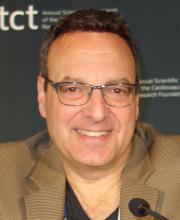User login
SAN DIEGO – The Supraflex drug-eluting stent is noninferior to Abbott’s Xience stent, according to results of the TALENT trial. Supfraflex elutes sirolimus from a bioabsorbable polymer, while Xience elutes everolimus from a durable polymer coating.
Stent technology has reached a “safety plateau,” which is leading to decisions based on economic factors, said Patrick Serruys, MD, during a presentation of the results at Transcatheter Cardiovascular Therapeutics annual meeting. Dr. Serruys is a professor of cardiology at the National Heart and Lung Institute of Imperial College in London.
The Indian government’s policy also requires companies to prove that their product is noninferior to proven stents. To satisfy that requirement, researchers conducted the Thin Strut Sirolimus-Eluting Stent in All Comers Population vs Everolimus-eluting Stent (TALENT) study. In this trial (NCT02870140), 1,435 patients from 23 sites were randomized to receive either the Supraflex stent, manufactured by India-based SMT, or the Xience stent.
The population was “all comers” who had symptomatic coronary artery disease that qualified for percutaneous coronary interventions, including chronic stable angina, silent ischemia, and acute coronary syndromes. The researchers followed patients out to 3 years.
The two groups were similar in their baseline characteristics, with the exception of previous coronary artery bypass graft, which was more frequent in the Xience group (7.7% versus 4.6%).
The primary endpoint of the study was a composite of cardiac death, target vessel myocardial infarction, and clinically indicated target lesion revascularization (CI-TLR). At 3 years, 5.3% of the Xience group experienced the composite outcome versus 4.9% of the Supraflex group, a nonsignificant difference. The result confirmed the noninferiority of Supraflex at a margin of 4% (P less than .001). When the adverse events were broken down individually in a per-protocol analysis, the only significant difference between the two groups was with respect to CI-TLR, which favored Supraflex (1.2% versus 3.1%; P = .021). There were seven deaths in the Supraflex arm versus two in the Xience group. However, there was no apparent explanation for the difference, and it may have been because of chance, according to Dr. Serruys.
“The performance of Xience was excellent in this trial, at 5.3% it had one of the lowest (adverse outcome rates) I have seen so far, but the Supraflex also did very well,” said Dr. Serruys at a press conference.
The results of the study have implications in countries with capped stent prices or where there are models for competitive pricing. “Market competitiveness may influence future decisions on which stent you use,” said Dr. Serruys.
Because the trial was designed with India’s regulatory environment in mind, it is unlikely to be applicable to marketing approval in the United States, but such inexpensive stents could be coming. They may drive down prices, but they could also have a dark side, according to Dr. Cohen. “The companies that make these kinds of stents don’t do the kind of innovation we’ve come to expect in the field. I don’t know if they can support the R&D programs that the companies that we currently use [can support],” he said.
TALENT was sponsored by SMT, which manufactures Supraflex, and by the European Clinical Research Institute. Dr. Serruys has consulted for, received honoraria from, or served on the speaker’s bureau for Abbott. Dr. Cohen has received grant support from Abbott Vascular, Boston Scientific, Edwards Lifesciences, Medtronic, Corvia Medical, and Svelte. He has consulted for, received honoraria, or served on the speaker’s bureau for Edwards Lifesciences and Medtronic.
SAN DIEGO – The Supraflex drug-eluting stent is noninferior to Abbott’s Xience stent, according to results of the TALENT trial. Supfraflex elutes sirolimus from a bioabsorbable polymer, while Xience elutes everolimus from a durable polymer coating.
Stent technology has reached a “safety plateau,” which is leading to decisions based on economic factors, said Patrick Serruys, MD, during a presentation of the results at Transcatheter Cardiovascular Therapeutics annual meeting. Dr. Serruys is a professor of cardiology at the National Heart and Lung Institute of Imperial College in London.
The Indian government’s policy also requires companies to prove that their product is noninferior to proven stents. To satisfy that requirement, researchers conducted the Thin Strut Sirolimus-Eluting Stent in All Comers Population vs Everolimus-eluting Stent (TALENT) study. In this trial (NCT02870140), 1,435 patients from 23 sites were randomized to receive either the Supraflex stent, manufactured by India-based SMT, or the Xience stent.
The population was “all comers” who had symptomatic coronary artery disease that qualified for percutaneous coronary interventions, including chronic stable angina, silent ischemia, and acute coronary syndromes. The researchers followed patients out to 3 years.
The two groups were similar in their baseline characteristics, with the exception of previous coronary artery bypass graft, which was more frequent in the Xience group (7.7% versus 4.6%).
The primary endpoint of the study was a composite of cardiac death, target vessel myocardial infarction, and clinically indicated target lesion revascularization (CI-TLR). At 3 years, 5.3% of the Xience group experienced the composite outcome versus 4.9% of the Supraflex group, a nonsignificant difference. The result confirmed the noninferiority of Supraflex at a margin of 4% (P less than .001). When the adverse events were broken down individually in a per-protocol analysis, the only significant difference between the two groups was with respect to CI-TLR, which favored Supraflex (1.2% versus 3.1%; P = .021). There were seven deaths in the Supraflex arm versus two in the Xience group. However, there was no apparent explanation for the difference, and it may have been because of chance, according to Dr. Serruys.
“The performance of Xience was excellent in this trial, at 5.3% it had one of the lowest (adverse outcome rates) I have seen so far, but the Supraflex also did very well,” said Dr. Serruys at a press conference.
The results of the study have implications in countries with capped stent prices or where there are models for competitive pricing. “Market competitiveness may influence future decisions on which stent you use,” said Dr. Serruys.
Because the trial was designed with India’s regulatory environment in mind, it is unlikely to be applicable to marketing approval in the United States, but such inexpensive stents could be coming. They may drive down prices, but they could also have a dark side, according to Dr. Cohen. “The companies that make these kinds of stents don’t do the kind of innovation we’ve come to expect in the field. I don’t know if they can support the R&D programs that the companies that we currently use [can support],” he said.
TALENT was sponsored by SMT, which manufactures Supraflex, and by the European Clinical Research Institute. Dr. Serruys has consulted for, received honoraria from, or served on the speaker’s bureau for Abbott. Dr. Cohen has received grant support from Abbott Vascular, Boston Scientific, Edwards Lifesciences, Medtronic, Corvia Medical, and Svelte. He has consulted for, received honoraria, or served on the speaker’s bureau for Edwards Lifesciences and Medtronic.
SAN DIEGO – The Supraflex drug-eluting stent is noninferior to Abbott’s Xience stent, according to results of the TALENT trial. Supfraflex elutes sirolimus from a bioabsorbable polymer, while Xience elutes everolimus from a durable polymer coating.
Stent technology has reached a “safety plateau,” which is leading to decisions based on economic factors, said Patrick Serruys, MD, during a presentation of the results at Transcatheter Cardiovascular Therapeutics annual meeting. Dr. Serruys is a professor of cardiology at the National Heart and Lung Institute of Imperial College in London.
The Indian government’s policy also requires companies to prove that their product is noninferior to proven stents. To satisfy that requirement, researchers conducted the Thin Strut Sirolimus-Eluting Stent in All Comers Population vs Everolimus-eluting Stent (TALENT) study. In this trial (NCT02870140), 1,435 patients from 23 sites were randomized to receive either the Supraflex stent, manufactured by India-based SMT, or the Xience stent.
The population was “all comers” who had symptomatic coronary artery disease that qualified for percutaneous coronary interventions, including chronic stable angina, silent ischemia, and acute coronary syndromes. The researchers followed patients out to 3 years.
The two groups were similar in their baseline characteristics, with the exception of previous coronary artery bypass graft, which was more frequent in the Xience group (7.7% versus 4.6%).
The primary endpoint of the study was a composite of cardiac death, target vessel myocardial infarction, and clinically indicated target lesion revascularization (CI-TLR). At 3 years, 5.3% of the Xience group experienced the composite outcome versus 4.9% of the Supraflex group, a nonsignificant difference. The result confirmed the noninferiority of Supraflex at a margin of 4% (P less than .001). When the adverse events were broken down individually in a per-protocol analysis, the only significant difference between the two groups was with respect to CI-TLR, which favored Supraflex (1.2% versus 3.1%; P = .021). There were seven deaths in the Supraflex arm versus two in the Xience group. However, there was no apparent explanation for the difference, and it may have been because of chance, according to Dr. Serruys.
“The performance of Xience was excellent in this trial, at 5.3% it had one of the lowest (adverse outcome rates) I have seen so far, but the Supraflex also did very well,” said Dr. Serruys at a press conference.
The results of the study have implications in countries with capped stent prices or where there are models for competitive pricing. “Market competitiveness may influence future decisions on which stent you use,” said Dr. Serruys.
Because the trial was designed with India’s regulatory environment in mind, it is unlikely to be applicable to marketing approval in the United States, but such inexpensive stents could be coming. They may drive down prices, but they could also have a dark side, according to Dr. Cohen. “The companies that make these kinds of stents don’t do the kind of innovation we’ve come to expect in the field. I don’t know if they can support the R&D programs that the companies that we currently use [can support],” he said.
TALENT was sponsored by SMT, which manufactures Supraflex, and by the European Clinical Research Institute. Dr. Serruys has consulted for, received honoraria from, or served on the speaker’s bureau for Abbott. Dr. Cohen has received grant support from Abbott Vascular, Boston Scientific, Edwards Lifesciences, Medtronic, Corvia Medical, and Svelte. He has consulted for, received honoraria, or served on the speaker’s bureau for Edwards Lifesciences and Medtronic.
REPORTING FROM TCT 2018
Key clinical point: Equivalent, cheaper stents could put economic pressure on choice of stent.
Major finding: At 1 year, there was no significant difference in a composite of death and cardiac events.
Study details: TALENT, a multicenter, randomized, controlled trial of 1,435 patients.
Disclosures: TALENT was sponsored by SMT, which manufactures Supraflex, and by the European Clinical Research Institute. Dr. Serruys has consulted for, received honoraria from, or served on the speaker’s bureau for Abbott. Dr. Cohen has received grant support from Abbott Vascular, Boston Scientific, Edwards Lifesciences, Medtronic, Corvia Medical, and Svelte. He has consulted for, received honoraria from, or served on the speaker’s bureau for Edwards Lifesciences and Medtronic.


